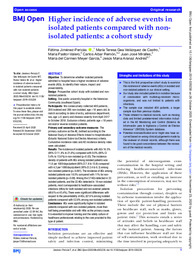Título :
Higher incidence of adverse events in
isolated patients compared with non-isolated
patients: a cohort study |
Autor :
Jiménez, Fátima 
GEA VELAZQUEZ DE CASTRO, MARÍA TERESA 
Pastor-Valero, Maria 
Aibar Remón, Carlos 
Miralles-Bueno, Juan Jose 
Meyer García, María del Carmen 
Aranaz Andrés, Jesús María  |
Editor :
BMJ Publishing Group |
Departamento:
Departamentos de la UMH::Salud Pública, Historia de la Ciencia y Ginecología |
Fecha de publicación:
2020-10 |
URI :
https://hdl.handle.net/11000/30519 |
Resumen :
Objective To determine whether isolated patients admitted to hospital have a higher incidence of adverse events (AEs), to identify their nature, impact and preventability.
Design Prospective cohort study with isolated and non-isolated patients.
Setting One public university hospital in the Valencian Community (southeast Spain).
Participants We consecutively collected 400 patients, 200 isolated and 200 non-isolated, age ≥18 years old, to match according to date of entry, admission department, sex, age (±5 years) and disease severity from April 2017 to October 2018. Exclusion criteria: patients age <18 years old and/or reverse isolation patients.
Primary and secondary outcome measures The primary outcome as the AE, defined according to the National Study of Adverse Effects linked to Hospitalisation (Estudio Nacional Sobre los Efectos Adversos) criteria. Cumulative incidence rates and AE incidence density rates were calculated.
Results The incidence of isolated patients with AEs 16.5% (95% CI 11.4% to 21.6%) compared with 9.5% (95% CI 5.4% to 13.6%) in non-isolated (p<0.03). The incidence density of patients with AEs among isolated patients was 11.8 per 1000 days/patient (95% CI 7.8 to 15.9) compared with 4.3 per 1000 days/patient (95% CI 2.4 to 6.3) among non-isolated patients (p<0.001). The incidence of AEs among isolated patients was 18.5% compared with 11% for non-isolated patients (p<0.09). Among the 37 AEs detected in 33 isolated patients, and the 22 AEs detected in 19 non-isolated patients, most corresponded to healthcare-associated infections (HAIs) for both isolated and non-isolated patients (48.6% vs 45.4%). There were significant differences with respect to the preventability of AEs, (67.6% among isolated patients compared with 52.6% among non-isolated patients).
Conclusions AEs were significantly higher in isolated patients compared with non-isolated patients, more than half being preventable and with HAIs as the primary cause. It is essential to improve training and the safety culture of healthcare professionals relating to the care provided to this type of patient.
|
Palabras clave/Materias:
isolated patients
non-isolated patients |
Área de conocimiento :
CDU: Ciencias aplicadas: Medicina |
Tipo documento :
application/pdf |
Derechos de acceso:
info:eu-repo/semantics/openAccess |
DOI :
http://dx.doi.org/10.1136/bmjopen-2019-035238 |
Aparece en las colecciones:
Artículos Salud Pública, Historia de la Ciencia y Ginecología
|
 La licencia se describe como: Atribución-NonComercial-NoDerivada 4.0 Internacional.
La licencia se describe como: Atribución-NonComercial-NoDerivada 4.0 Internacional.
.png)
